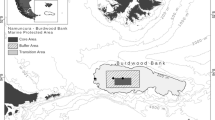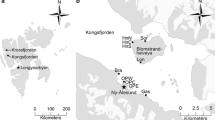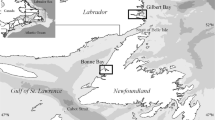Abstract
The first non-coastal Sub-Antarctic Marine Protected Area (Namuncurá) in Argentina was created in 2013, at Burdwood Bank (MPAN-BB), an undersea plateau located about 200 km south from Malvinas/Falkland Islands, SW Atlantic Ocean. The main contribution of this work was to explore fish species composition and the structure of fish assemblages in three different zones of the MPAN-BB with different conservation strategies and different surrounding areas. Twenty-two fishing trawls were performed using a demersal bottom trawl pilot net at depths between 71 and 608 m. A total of 667 fish belonging to 30 species were collected in the surveyed area. The richest family in terms of species number was Nototheniidae (seven species), followed by Macrouridae, Myxinidae and Zoarcidae (four species each), then Moridae and Arhynchobatidae (three species each), and finally Muraenolepididae and Psychrolutidae (two species each). The remaining families were represented by a single species. Three significantly different fish assemblages were detected. These distinct assemblages were largely circumscribed at the plateau, the shelf-break slope, and the area west of the BB. The results showed that fish diversity in the MPAN-BB is relatively high constituting ~ 10% of the fish composition reported for the Atlantic sector of the Magellanic Province. The present data suggest that fishes are an important component of the benthic community planned to be protected by the implementation of the MPAN-BB. These findings have important implications for habitat preservation and threatened species conservation.



Similar content being viewed by others
References
Acha EM, Mianzan HW, Guerrero RA, Favero M, Bava J (2004) Marine fronts at the continental shelves of austral South America: physical and ecological processes. J Marine Syst 44:83–105. https://doi.org/10.1016/j.jmarsys.2003.09.005
Arntz W, Brey T (2003) Expedition Antarktis XIX/5 (LAMPOS) of RV ‘‘Polarstern’’ in 2002. Ber Polarforsch Meeresforsch 462:124
Attrill MJ, Power M (2002) Climatic influence on a marine fish assemblage. Nature 417:275. https://doi.org/10.1038/417275a
Balestrini C, Manzella G, Lovrich GA (1998) Simulacion de corrientes en el Canal Beagle y Bahia Ushuaia, mediante un modelo bidimensional. Serv Hidrog Naval Dto Oceanog Inf Tec 98:1–58
Clarke KR, Somerfield PJ, Gorley RN (2008) Testing of null hypotheses in exploratory community analyses: similarity profiles and biota-environment linkage. J Exp Mar Biol Ecol 366:56–69. https://doi.org/10.1016/j.jembe.2008.07.009
Claudet J (2011) Marine protected areas: a multidisciplinary approach. Cambridge University Press, London
Colwell RK (2013) EstimateS: Statistical estimation of species richness and shared species from samples. Version 9. User's Guide and application published at: https://purl.oclc.org/estimates
Cousseau MB, Perrotta RG (2004) Peces marinos de Argentina. Biología, distribución, pesca. Publishers INIDEP, Mar del Plata
Cousseau MB, Barbini SA, Figueroa DE (2012) The presence of southern fishes in the Argentinian continental shelf and adjacent areas. Mar Biodivers 42:73–78. https://doi.org/10.1007/s12526-011-0088-x
Cousseau MB, Figueroa DE, Díaz De Astarloa JM, Mabragaña E, Lucifora LO (2007) Rayas, chuchos y otros batoideos del Atlántico Sudoccidental (34°S-55°S). Publishers INIDEP, Mar del Plata
Dayton PK (2003) The importance of the natural sciences to conservation. Am Nat 162:1–13. https://doi.org/10.1086/376572
Dehens LA, Fanning LM (2018) What counts in making marine protected areas (MPAs) count? The role of legitimacy in MPA success in Canada. Ecol Indic 86:45–57. https://doi.org/10.1016/j.ecolind.2017.12.026
Dulvy NK, Rogers SI, Jennings S, Stelzenmüller V, Dye SR, Skjoldal HR (2008) Climate change and deepening of the North Sea fish assemblage: a biotic indicator of warming seas. J App Ecol 45:1029–1039. https://doi.org/10.1111/j.1365-2664.2008.01488.x
Eschmeyer WN, Fricke R, Van der Laan R (2017) Catalog of Fishes. California Academy of Sciences, San Francisco. https://researcharchive.calacademy.org/research/ichthyology/catalog/fishcatmain.asp
Falabella V, Campagna C, Caille G, Krapovickas S, Moreno D, Michelson A, Piola A, Schejter L, Zelaya D (2013) Banco Burdwood: Contribuciones para el establecimiento de una línea de base y plan de manejo de la futura Área Marina Protegida. Preliminar Report, p 51
Friedlander AM, Parrish JD (1998) Habitat characteristics affecting fish assemblages on a Hawaiian coral reef. J Exp Mar Biol Ecol 224:1–30. https://doi.org/10.1016/S0022-0981(97)00164-0
Gon O, Heemstra PC (1990) Fishes of the Southern Ocean. JLB Smith Inst Ichthyol, Grahamstown
Gosztonyi AE (1981) Results of the research cruises of FRV "Walther Herwig" to South America. LIX. Lycodonus malvinensis n. sp. (Pisces, Blennioidei), another new zoarcid fish from the western South Atlantic Ocean. Arch Fischereiwiss 31:151–159
Guarderas AP, Hacker SD, Lubchenco J (2008) Current Status of Marine Protected Areas in Latin America and the Caribbean. Conserv Biol 22:1630–1640. https://doi.org/10.1111/j.1523-1739.2008.01023.x
Guerrero RA, Baldoni A, Benavides HR (1999) Oceanographic conditions at the southern end of the Argentine continental slope. In: Sánchez RP (ed) Reproductive habitat, biology and acoustic biomass estimates of the southern blue whiting (Micromesistius australis) in the sea off southern Patagonia. Publishers INIDEP, Mar del Plata, pp 7–22
Hinz H, Prieto V, Kaiser MJ (2009) Trawl disturbance on benthic communities: chronic effects and experimental predictions. Ecol Appl 19:761–773. https://doi.org/10.1890/08-0351.1
Holbrook SJ, Kingsford MJ, Schmitt RJ, Stephens JS (1994) Spatial and temporal patterns in assemblages of temperate reef fish. Am Zool 34:463–475. https://doi.org/10.1093/icb/34.3.463
Knust R, Gerdes D, Mintenbeck K (2012) The expedition of the research vessel Polarstern to the Antarctic in 2011 (ANTXXVII/3) (CAMBIO). Rep Pol Mar Res 644:1–202
Krebs CJ (1989) Ecological methodology. Addison and Wesley Longman Pp, California
Laptikhovsky V (2004) A comparative study of diet in three sympatric populations of Patagonotothen species (Pisces: Nototheniidae). Polar Biol 27:202–205. https://doi.org/10.1007/s00300-003-0573-1
Llompart F, Delpiani M, Lattuca E, Delpiani G, Cruz-Jiménez A, Orlando P, Ceballos S, Díaz de Astarloa JM, Vanella F, Fernández D (2015) Spatial patterns of summer demersal fish assemblages around the Antarctic Peninsula and South Shetland Islands. Antarc Sci 27:109–117. https://doi.org/10.1017/S0954102014000352
López Gappa J (2000) Species richness of marine Bryozoa in the continental shelf and slope off Argentina (south-west Atlantic). Divers Distrib 6:15–27. https://doi.org/10.1046/j.1472-4642.2000.00067.x
Lubchenco J, Palumbi SR, Gaines S, Andelman S (2003) Plug- ging a hole in the ocean: the emerging science of marine reserves. Ecol Appl 13:S3–S7. https://doi.org/10.1890/1051-0761(2003)013[0003:PAHITO]2.0.CO;2
Magurran AE, Khachonpisitsak S, Ahmad AB (2011) Biological diversity of fish communities: pattern and process. J Fish Biol 79:1393–1412. https://doi.org/10.1111/j.1095-8649.2011.03091.x
Martin J, Veccia M (2014) Estudio oceanográfico del Canal Beagle y Atlántico Sudoccidental. Informe campaña Área Protegida Namuncurá Banco Burdwwod, CONICET, Argentina
Matano RP, Palma ED, Combes V (2019) The Burdwood Bank circulation. J Geophys Res Oceans 124:6904–6926. https://doi.org/10.1029/2019JC015001
Menni RC, Lucifora LO (2007) Condrictios de la Argentina y Uruguay. FCNyM, Universidad Nacional de La Plata, Serie Técnica-Didáctica, La Plata, Argentina, ProBiota
Menni RC, Ringuelet RA, Aramburu RH (1984) Peces marinos de la Argentina y Uruguay. Editorial Hemisferio Sur, Buenos Aires
Moreno CE, Halffter G (2000) Assessing the completeness of bat biodiversity inventories using species accumulation curves. J Appl Ecol 37:149–158. https://doi.org/10.1046/j.1365-2664.2000.00483.x
Oksanen J, Blanchet FG, Friendly M, Kindt R, Legendre P, Mcglinn D, Minchin PR, O'hara RB, Simpson GL, Solymos P, Stevens MHH, Szoecs E, Wagner H (2016) Vegan: Community Ecology Package. R package version 2.4–1. https://CRAN.R-project.org/package=vegan
Pakhomov EA, Bushula T, Kaehler S, Watkins BP, Leslie RW (2006) Structure and distribution of the slope fish community in the vicinity of the sub-Antarctic Prince Edward Archipelago. J Fish Biol 68:1834–1866. https://doi.org/10.1111/j.1095-8649.2006.01076.x
Pauly D (2009) Beyond duplicity and ignorance in global fisheries. Sci Mar 73(2):215–224. https://doi.org/10.3989/scimar.2009.73n2215
Perry AL, Low PJ, Ellis JR, Reynolds JD (2005) Climate change and distribution shifts in marine fishes. Science 308:1912–1915. https://doi.org/10.1126/science.1111322
R Core Team (2017) R: a language and environment for statistical computing. R Foundation for Statistical Computing, Vienna. https://www.R-project.org/
Roberts C, O’leary B, Mccauley D, Cury P, Duarte C, Lubchenco J, Pauly D, Sáenz-Arroyo A, Sumaila U, Wilson R, Worm B, Castilla JM (2017) Marine reserves can mitigate and promote adaptation to climate change. PNAS Early Edition: 1–9
Sabatini M, Álvarez Colombo G, Ramirez FC (1999) Zooplankton biomass in the reproductive area of the southern blue whiting (Micromesistius australis). In: Sánchez RP (ed) Reproductive habitat, biology and acoustic biomass estimates of the southern blue whiting (Micromesistius australis) in the sea off southern Patagonia. Publishers INIDEP, Mar del Plata, pp 23–35
Sala E, Giakoumi S (2017) No-take marine reserves are the most effective protected areas in the ocean. ICES J Mar Sci 75:1166–1168. https://doi.org/10.1093/icesjms/fsx059
Sánchez RP, Ciechomski JD (1995) Spawning and nursery grounds of pelagic fish species in the sea-shelf off Argentina and adjacent areas. Sci Mar 59:455–478
Schejter L, Acuña FH, Garese A, Cordeiro R, Pérez CD (2018) Sea pens (Cnidaria: Pennatulacea) from Argentine waters: New distributional records and first report of associated sea anemones. Pan-Am J Aquat Sci 13:292–301
Schejter L, Bertolino M, Calcinai B, Cerrano C, Pansini M (2012) Banco Burdwood: resultados preliminares sobre composición y riqueza específica de esponjas (Phylum Porifera), a partir de muestras colectadas en la campaña del buque rompehielos estadounidense ‘‘Nathaniel B. Palmer’’, abril-mayo 2008. INIDEP Research Report, Argentina
Schejter L, Bremec CS (2019) Stony corals (Anthozoa: Scleractinia) of Burdwood bank and neighboring areas, SW Atlantic Ocean. Sci Mar 63:247–260. https://doi.org/10.3989/scimar.04863.10A
Schejter L, Martin J, Lovrich G (2017) Unveiling the submarine landscape of the Namuncurá Marine Protected Area, Burdwood Bank, SW Atlantic Ocean. Pan Am J Aqua Sci 12:248–253
Schejter L, Rimondino C, Chiesa, Diaz De Astarloa J, Doti B, Elias R, Escolar M, Genzano G, Lopez Gappa J, Tatian M, Zelaya D, Cristobo J, Perez C, Cordeiro R, Bremec C (2016) Namuncurá Marine Protected Area: an oceanic hot spot of benthic biodiversity at Burdwood Bank, Argentina. Polar Biol 39:1–12. https ://doi.org/10.1007/s0030 0–016–1913–2
Schroeder DM, Love MS (2004) Ecological and political issues surrounding decommissioning of offshore oil facilities in the Southern California Bight. Ocean Coast Manage 47:21–48. https://doi.org/10.1016/j.ocecoaman.2004.03.002
Soberon J, Llorente J (1993) The use of species accumulation functions for the prediction of species richness. Conserv Biol 7:480–488. https://doi.org/10.1046/j.1523-1739.1993.07030480.x
Sokal RR, Rohlf JA (1979) Biometria. H. Blume, Barcelona, Principios y Métodos Estadisticos en la Investigación Biológica, p 832
Tatián M, Antacli JC, Sahade R (2005) Ascidians (Tunicata Ascidiacea) species distribution along the Scotia Arc. Sci Mar 62: 205–214.
Whitaker D, Christman M (2014) Clustsig: Significant Cluster Analysis. R package version 1.1. https://CRAN.R-project.org/package=clustsig.
Wisner RL, Mc Millan C (1995) Review of the new world hagfishes of the genus Myxine (Agnatha, Myxinidae) with descriptions of nine new species. Fish B-NOAA 93:530–550
Zamponi M (2008a) Informe Banco Burdwood. Cnidaria. Informe Tratado y Aprobado en el Acta CFP N° 18/2008, Mar del Plata
Zamponi M (2008) La corriente de Malvinas: ¿una vía de dispersión para cnidarios bentónicos de aguas frías? Rev Real Aca Gall Cs 7:183–203
Zunino G, Ichazo MM (1979) Los peces demersales del Banco Burdwood: distribución, abundancia de las especies y frecuencia de tallas (según datos de los B/I Walther Herwig y Shinkai Maru, campañas 1978–1979). Final report, Oceanografía Biológica, Universidad de Buenos Aires
Acknowledgements
We would like to thank the captain and crew of the OV ‘‘Puerto Deseado’’, and all the scientific staff for helping during sampling, as well as to Drs. Daniel Roccatagliata and Laura Schejter for their commitment to coordinating the work on board. Gustavo Lovrich, as scientific and academic coordinator, supported and encouraged all research projects dealing with the Namuncurá MPA, Burdwood Bank and the surrounding areas. We are especially indebted to D. Piepenburg, M. B Cousseau and an anonymous reviewer for their suggestions and corrections, which we believe greatly improved this manuscript. JMDA greatly appreciates the assistance of Thomas Munroe (National Systematics Laboratory, Smithsonian Institution, Washington, D.C.) for reading and correcting the English text.
Funding
This study was supported by grants from Consejo Nacional de Investigaciones Científicas y Técnicas (CONICET-Argentina), PIP 0440 to DF Project-FONDO IBOL to SMD, EM, JMDA. D. M. Vazquez was supported by a CONICET fellowship. Operating costs were afforded by funds of the creation law of MPA Namuncurá—Banco Burdwood (Law 26.875). This is the scientific contribution 42 of the Marine Protected Area Namuncurá.
Author information
Authors and Affiliations
Corresponding author
Ethics declarations
Conflict of interest
The authors declare that they have no conflicts of interest.
Ethical approval
All permissions for collecting samples from the’Marine Protected Area Namuncurá (MPAN-BB) were issued by its Administrative Council by authorizing and funding the scientific missions. All sampling procedures and experimental manipulations follow the guidelines approved by the Universidad de Buenos Aires (Facultad de Ciencias Exactas y Naturales, Bioterio Central,https://exactas.uba.ar/cicual/).
Additional information
Publisher's Note
Springer Nature remains neutral with regard to jurisdictional claims in published maps and institutional affiliations.
Rights and permissions
About this article
Cite this article
Delpiani, S.M., Bruno, D.O., Vazquez, D.M. et al. Structure and distribution of fish assemblages at Burdwood Bank, the first Sub-Antarctic Marine Protected Area “Namuncurá” in Argentina (Southwestern Atlantic Ocean). Polar Biol 43, 1783–1793 (2020). https://doi.org/10.1007/s00300-020-02744-w
Received:
Revised:
Accepted:
Published:
Issue Date:
DOI: https://doi.org/10.1007/s00300-020-02744-w




